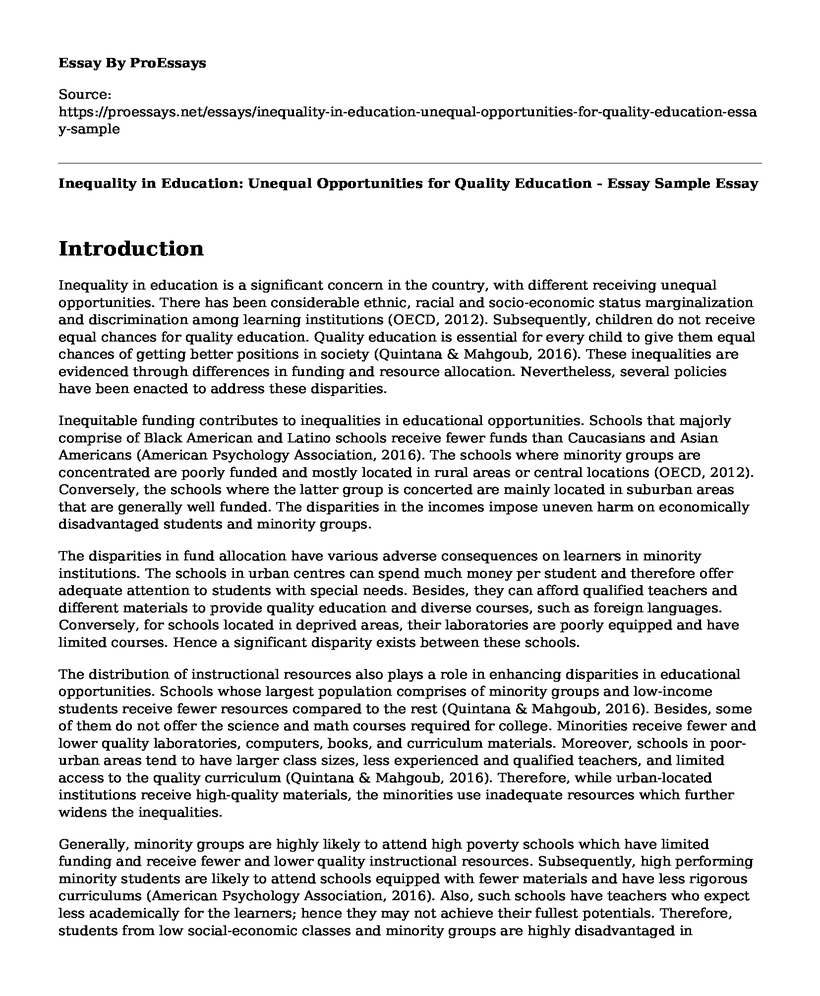Introduction
Inequality in education is a significant concern in the country, with different receiving unequal opportunities. There has been considerable ethnic, racial and socio-economic status marginalization and discrimination among learning institutions (OECD, 2012). Subsequently, children do not receive equal chances for quality education. Quality education is essential for every child to give them equal chances of getting better positions in society (Quintana & Mahgoub, 2016). These inequalities are evidenced through differences in funding and resource allocation. Nevertheless, several policies have been enacted to address these disparities.
Inequitable funding contributes to inequalities in educational opportunities. Schools that majorly comprise of Black American and Latino schools receive fewer funds than Caucasians and Asian Americans (American Psychology Association, 2016). The schools where minority groups are concentrated are poorly funded and mostly located in rural areas or central locations (OECD, 2012). Conversely, the schools where the latter group is concerted are mainly located in suburban areas that are generally well funded. The disparities in the incomes impose uneven harm on economically disadvantaged students and minority groups.
The disparities in fund allocation have various adverse consequences on learners in minority institutions. The schools in urban centres can spend much money per student and therefore offer adequate attention to students with special needs. Besides, they can afford qualified teachers and different materials to provide quality education and diverse courses, such as foreign languages. Conversely, for schools located in deprived areas, their laboratories are poorly equipped and have limited courses. Hence a significant disparity exists between these schools.
The distribution of instructional resources also plays a role in enhancing disparities in educational opportunities. Schools whose largest population comprises of minority groups and low-income students receive fewer resources compared to the rest (Quintana & Mahgoub, 2016). Besides, some of them do not offer the science and math courses required for college. Minorities receive fewer and lower quality laboratories, computers, books, and curriculum materials. Moreover, schools in poor-urban areas tend to have larger class sizes, less experienced and qualified teachers, and limited access to the quality curriculum (Quintana & Mahgoub, 2016). Therefore, while urban-located institutions receive high-quality materials, the minorities use inadequate resources which further widens the inequalities.
Generally, minority groups are highly likely to attend high poverty schools which have limited funding and receive fewer and lower quality instructional resources. Subsequently, high performing minority students are likely to attend schools equipped with fewer materials and have less rigorous curriculums (American Psychology Association, 2016). Also, such schools have teachers who expect less academically for the learners; hence they may not achieve their fullest potentials. Therefore, students from low social-economic classes and minority groups are highly disadvantaged in accessing educational opportunities.
Several provisions and proposals have been proposed to address these differences in educational institutions, including resource equalization and curriculum reforms. The efforts to equalize resources will ensure help address the inequalities existing across states, among courses, and among schools within particular districts (OECD, 2012). Hence policies will be adopted to ensure all schools have a competent staff equipped with the right curriculum and teaching strategies and access to necessary materials.
Curriculum reforms entail adopting a similar learning program for all students across the nation. As such, minorities will no longer be subjected to simple tests that do not align with the demands of the current world (Quintana & Mahgoub, 2016). All students will, therefore, access materials that are proposed and enacted by state and national associations. As such, all classrooms will have access to the same curriculum regardless of their location. Subsequently, all learners will have access to quality education hence reducing or eliminating the existing inequalities.
References
American Psychology Association. (2016). Ethnic and racial minorities & socio-economic status.
OECD, O. (2012). Equity and quality in education: Supporting disadvantaged students and schools. http://www.oecd.org/education/school/50293148.pdf
Quintana, S. M., & Mahgoub, L. (2016). Ethnic and racial disparities in education: Psychology's role in understanding and reducing disparities. Theory Into Practice, 55(2), 94-103. https://www.apa.org/ed/resources/racial-disparities.pdf
Cite this page
Inequality in Education: Unequal Opportunities for Quality Education - Essay Sample. (2023, May 22). Retrieved from https://proessays.net/essays/inequality-in-education-unequal-opportunities-for-quality-education-essay-sample
If you are the original author of this essay and no longer wish to have it published on the ProEssays website, please click below to request its removal:
- Child Development: Importance of Reading to Children at an Early Age Essay
- Essay on Attentive Reading: The Foundation for Good Critical Thinking
- Essay Sample on Developmental Psychology: Parenting Related to Development of Children
- Phi Theta Kappa - Executive Director Candidate Speech
- Child Development & Growth: Professional Caregiver Guidelines - Essay Sample
- Essay Example on Beliefs: Essential for Knowledge, Despite Background
- Planning for Assessments - Essay Sample







